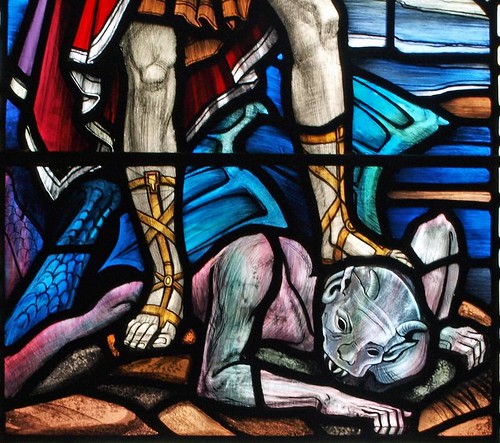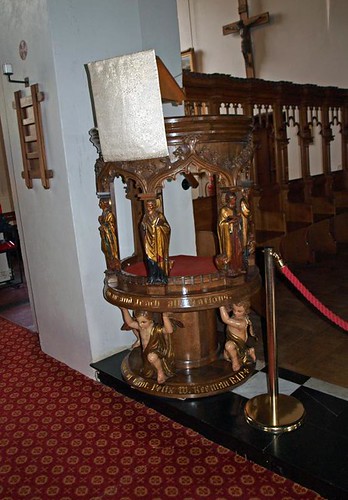Built in the 1920's to the design of the parish priest, Fr FW Gilbert, it stands as his personal testament to God. Full of good period glass, a very Catholic reredos, lectern and rood; unusually a SE tower but, to my mind, the most exceptional feature is the Lady Chapel which is a scaled replica of Lourdes.
A rich priest's homage to Gothic architecture with a distinct Catholic twist - I wish this was my parish church!
Neither Pevsner nor Mee covered it (inherent anti Catholicism at work?) so Taking Stock instead:
An idiosyncratic Gothic church of the 1920s, very much a personal
work by the parish priest Fr F. W. Gilbert, but closely following the
design of Charles Nicholson’s church of St Alban at Westcliff-on-Sea.
The church was sympathetically extended in the 1960s. The interior is rich in fittings, some designed by Fr Gilbert.
The original church (now the parish hall) began life as a
timber-framed, corrugated iron drill hall, originally built for the
Essex Volunteers in 1900 under the supervision of Major Burles and
purchased in 1913. The site of the present church was purchased by the
Rev. F.W. Gilbert in 1924, using donations and his private money. It
appears that Fr Gilbert acted as his own architect, his design borrowing
heavily from that of the Anglican church of St Alban the Martyr at
Westcliff-on-Sea, built in 1898-1908 from designs by Nicholson &
Corlette. The Gilbert family promised £2,000 once building
work commenced. The contract price was £12,234. The builders were Messrs
Marshall & Smith of Grays but Fr Gilbert acted as his own clerk of
works, using local labour, including unemployed men from Grays. The
foundation stone was laid on 7 October 1924 and the church opened in
September 1925. The presbytery was built in 1925.
The church was sympathetically extended in 1965-66 by Burles, Newton & Partners, in the same style and materials; the west wall was moved twenty feet further out to create a choir gallery, west door and porch and a baptistery with organ chamber above. Proposals to replace the old hall with a new and larger building were prepared in 2007 but have not yet been implemented.
The church is a large and handsome structure in a free Gothic style. The walls are faced with random rubble with stone dressings. Apparently much of the stone was quarried near Glasgow and was originally used as ballast in lighters intended for the Gallipoli campaign, which were later bought by a local shipowner, who donated the stone for the building of the church. The roof is covered in plain tiles. On plan the church comprises a long nave and sanctuary under a continuous roof swept down over north and south aisles, southwest porch, northwest organ chamber, southeast double transept and southeast tower. The gabled west end is Burles & Newton’s work of the 1960s and has a broad straight-headed doorway flanked by small trefoiled windows with a large six-light traceried window above. On the north side is a tall transeptal organ chamber and then the low side wall of the north aisle with three pairs of small trefoiled windows. On the south side is a small projecting porch and then the low side wall of the south aisle, a double transept with three-light traceried windows in the gabled ends and then the bold square south east tower. The tower is of three stages with a traceried two-light window on the south side of the lowest stage and pairs of small openings in the two stages above. The tower has a single large diagonal buttress at the southeast corner, crenellated flint-faced parapets and a tiled spirelet. The east end wall of the sanctuary is articulated with three round-headed blind arches. This wall fronts the garden of the large presbytery which is attached to the northeast corner of the church, and the church and presbytery together form a strong architectural composition.
The interior walls are all plastered and painted with plain flooring of timber. There is a west gallery in the 1960s extension and nave arcades of four bays of simple pointed chamfered arches on square chamfered concrete piers. Above each pier the nave is spanned by the tie beams of the roof and above them is a five-sided timbered ceiling. The aisles have lean-to roofs and are also timbered. The east bay on the south side is a small transept. There is no chancel arch in the usual sense, but the division between nave and sanctuary is marked by pilaster strips on the walls with a rood beam at half- height and a timber rib spanning the roof between them. The sanctuary has a single large open arch on each side and is richly furnished. The east wall in particular is lined to full-height with carved decoration. The floor is black and white marble. On the south side of the sanctuary is a second transept divided from the first by a double arch resting on dwarf double columns with ornamental Gothic capitals. In the east wall of this transept a chamfered pointed arch leads to the base of the tower which contains a Lourdes grotto.
The church is rich in fittings. These include the carved timber reredos filling the whole east wall, the extraordinary pulpit with figures of evangelists supported by cherubs, apparently designed by Fr Gilbert, who also designed the figures of the rood beam, the elaborate oak stalls in the sanctuary and the font at the west end of the nave given in memory of Col. Knight (d.1891) with its stone bowl on clustered columns and a surrounding floor of Cosmati work.
There is some stained glass in the church including the west window by Whitefriars and other windows by Goddard & Gibbs. The scale model of the Lourdes grotto was built by Cyril Psaila (d. 1931).
The church was sympathetically extended in 1965-66 by Burles, Newton & Partners, in the same style and materials; the west wall was moved twenty feet further out to create a choir gallery, west door and porch and a baptistery with organ chamber above. Proposals to replace the old hall with a new and larger building were prepared in 2007 but have not yet been implemented.
The church is a large and handsome structure in a free Gothic style. The walls are faced with random rubble with stone dressings. Apparently much of the stone was quarried near Glasgow and was originally used as ballast in lighters intended for the Gallipoli campaign, which were later bought by a local shipowner, who donated the stone for the building of the church. The roof is covered in plain tiles. On plan the church comprises a long nave and sanctuary under a continuous roof swept down over north and south aisles, southwest porch, northwest organ chamber, southeast double transept and southeast tower. The gabled west end is Burles & Newton’s work of the 1960s and has a broad straight-headed doorway flanked by small trefoiled windows with a large six-light traceried window above. On the north side is a tall transeptal organ chamber and then the low side wall of the north aisle with three pairs of small trefoiled windows. On the south side is a small projecting porch and then the low side wall of the south aisle, a double transept with three-light traceried windows in the gabled ends and then the bold square south east tower. The tower is of three stages with a traceried two-light window on the south side of the lowest stage and pairs of small openings in the two stages above. The tower has a single large diagonal buttress at the southeast corner, crenellated flint-faced parapets and a tiled spirelet. The east end wall of the sanctuary is articulated with three round-headed blind arches. This wall fronts the garden of the large presbytery which is attached to the northeast corner of the church, and the church and presbytery together form a strong architectural composition.
The interior walls are all plastered and painted with plain flooring of timber. There is a west gallery in the 1960s extension and nave arcades of four bays of simple pointed chamfered arches on square chamfered concrete piers. Above each pier the nave is spanned by the tie beams of the roof and above them is a five-sided timbered ceiling. The aisles have lean-to roofs and are also timbered. The east bay on the south side is a small transept. There is no chancel arch in the usual sense, but the division between nave and sanctuary is marked by pilaster strips on the walls with a rood beam at half- height and a timber rib spanning the roof between them. The sanctuary has a single large open arch on each side and is richly furnished. The east wall in particular is lined to full-height with carved decoration. The floor is black and white marble. On the south side of the sanctuary is a second transept divided from the first by a double arch resting on dwarf double columns with ornamental Gothic capitals. In the east wall of this transept a chamfered pointed arch leads to the base of the tower which contains a Lourdes grotto.
The church is rich in fittings. These include the carved timber reredos filling the whole east wall, the extraordinary pulpit with figures of evangelists supported by cherubs, apparently designed by Fr Gilbert, who also designed the figures of the rood beam, the elaborate oak stalls in the sanctuary and the font at the west end of the nave given in memory of Col. Knight (d.1891) with its stone bowl on clustered columns and a surrounding floor of Cosmati work.
There is some stained glass in the church including the west window by Whitefriars and other windows by Goddard & Gibbs. The scale model of the Lourdes grotto was built by Cyril Psaila (d. 1931).



No comments:
Post a Comment